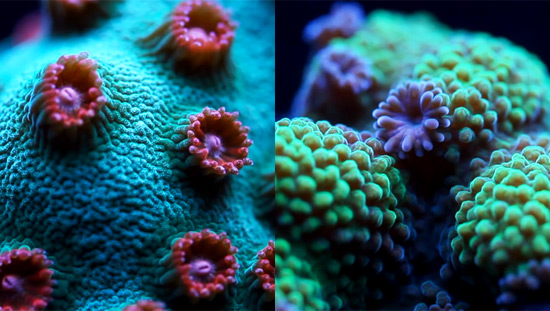
A few years ago, if you asked me about Astreopora or Cyphastrea, I probably would not have a whole lot to contribute to the discussion. They were (and still are to a large degree) some of the most rare corals imported and seldom seen in stores. I still remember the first time I saw a “Meteor Shower” Cyphastrea and was blown away by its incredible contrast of red and blue. Over the years, more and more color morphs made their way stateside and, thankfully, people started propagating them.
They are similar…
We try our best to separate corals into their respective categories to make it easier to shop for stuff, and occasionally we run into close calls like Cyphastrea and Astreopora that are sometimes really difficult to tell apart.
Obviously, their appearance is similar. They have small polyps that grow out from a web-like, textured coenosteum (calcareous skeleton). Astreopora appear to grow polyps on top of little raised mounds while Cyphastrea seem have their polyps tight against the coenosteum. The two corals grow in much the same fashion in that they encrust the substrate around them rather than form branches or tubercles.

The care requirements of both Cyphastrea and Astreopora are similar. They do well in low light and moderate flow. In fact, I would venture to say that these corals do best in the lowest light systems imaginable. Both Astreopora and Cyphastrea change color dramatically, but Cyphastrea in particular look like completely different corals from season to season.
When they get too much light, they turn an unflattering brown color and stop growing. The specimens we sell in the summer look nothing like the ones we sell in the winter.
As for feeding, we do not go out of our way to spot feed them. We’ve tried some feeding with finely ground pellet food with mixed results. If you are curious, you can take a look at feeding responses in the videos for Reef Roids and Coral Frenzy.
…But also so different
Despite the similarities outlined above, it turns out that, from a taxonomic viewpoint, these corals could not be more different. Astreopora are from the family Acroporidae. If that sounds remarkably similar to Acropora, your mind is not playing tricks on you. Acropora are also from that family, as are other SPS such as Montipora and Anacropora.
Cyphastrea, on the other hand, are from the family Faviidae. If that happens to sound a little like a popular brain coral…well, it does for a reason. Faviidae is a large family that contains most of what are referred to in the hobby as brain corals, such as Favia, Favites, and even certain chalices like Echinopora.
So we have these two corals that look really similar and behave similarly but are categorized in really different areas of the animal kingdom. It goes to show just how much significance scientists place on unseen details in the classification of these corals, such as skeletal structure under the skin. DNA testing is also playing a significant role in classification.
Speaking of DNA testing, some recent zoology-related publications have redefined several major genera of corals based on genetic makeup as well as physical traits. Classifications of all life on earth are constantly re-sorted as information becomes available, and it’s especially true for organisms like corals that were initially classified in the 1800’s.
Author: Than Thein



